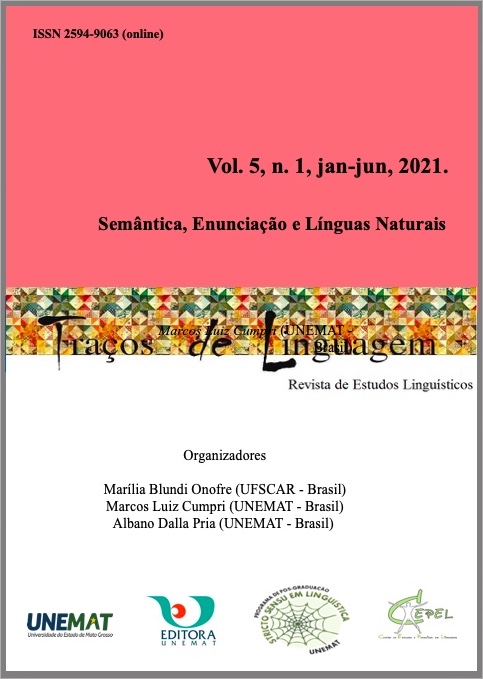The EM marker in the elaboration of temporal representations
DOI:
https://doi.org/10.30681/2594.9063.2021v5n1id5993Keywords:
Preposition EM, Time, Semantic IdentityAbstract
The preposition EM is invariably linked to the time value. We find it in all classifications of traditional grammars. However, the classificatory works that deal with the preposition as an introducer of temporal complements seem to be insufficient to account for the multiple cotextual fluctuations, as well as the semantic identity of the marker in focus. In this work, considering the semantic domain of the construction of time in linguistic enunciation, we aim to describe the cotextual variation of the preposition EM, that is, to specify which temporal representations are involved in the different enunciative scenarios to which this marker is integrated, and, to furthermore, to propose a hypothesis of its meaning invariance, that is, to determine the organizing principles that preside over the elaboration of such representations.
Downloads
References
ASHINO, F.; FRANCKEL, J.-J.; PAILLARD, D. Prépositions et rection verbale étude des prépositions: avec, contre, em, par, parmi, pour. Peter Lang AG International Academic Publishers, 2017.
CULIOLI, A. Pour une linguistique de l’énonciation tome 1. Opérations et représentations. Paris: Ophrys, 1990.
CULIOLI, A. Pour une linguistique de l’énonciation tome 2. Formalisation et opérations. Paris: Ophrys, 1999a.
CULIOLI, A. Pour une linguistique de l’énonciation tome 3. Domaine notionnel. Paris: Ophrys, 1999b.
DE VOGUÉ, S.; FRANCKEL, J.-J.; PAILLARD, D. Linguagem e enunciação: representação, referenciação e regulação. São Paulo: Contexto, 2011.
FRANCKEL, J.-J.; PAILLARD, D. Grammaire des prépositions. T.1. Paris: Ophrys, 2007.
LEEMAN, Danielle; VAGUER, Céline. La préposition peut-elle être prédicative? Le cas de la préposition en. 2016. Verbum (Presses Universitaires de Nancy), Université de Nancy II, 2014, XXXVI, pp. 397-420.
ROMERO, M. Le fonctionnement sémantique de la préposition POR en portugais brésilien. Faits de Langues, Les Cahiers, Paris: Ophrys, n. 3, p. 209-232, 2011.
ROMERO, M. Processos enunciativos e identidade semântica da preposição POR.
Cadernos do IL. Porto Alegre, nº 46, p.149-170, 2013.
ROMERO, M. Léxico, invariancia y actividad de lenguaje. In. GARCÍA-MOLINS, A. L., JIMÉNEZ, D. J. (Ed.). Enacción y léxico. Valencia: Tirant Humanidades, 2017.
ROMERO, M.; VILELA, T. R. O uso interproposicional de POR em uma descrição unitária de funcionamento da preposição. In. DIAS, L. F. et alli (orgs.) Enunciação e materialidade linguística. BH: Ed. UFMG, 2015.
VILELA, T. R. Educação léxico-gramatical: um estudo semântico-enunciativo da preposição COM. Dissertação (Mestrado). São Paulo: Universidade Federal de São Paulo (2016), 190 p.
VILELA, T. R.; ROCHA, E. G. L. Um breve panorama: descrição e abordagem metodológica de preposições no português brasileiro. Revista Estudos Linguísticos GEL. v. 46.
Downloads
Published
Issue
Section
License
Copyright (c) 2021 Traços de Linguagem - Revista de Estudos Linguísticos

This work is licensed under a Creative Commons Attribution-NonCommercial-ShareAlike 4.0 International License.

